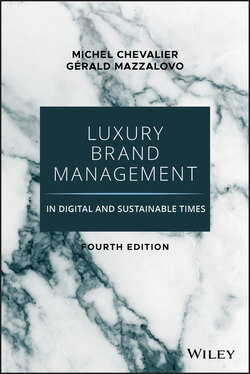Читать книгу Luxury Brand Management in Digital and Sustainable Times - Michel Chevalier - Страница 25
The Semiotic Square of the Consumption Values
ОглавлениеWe briefly present a tool that will be described in more detail in Chapter 7. We anticipate its use because it can support some reasoning about luxury, especially with regard to the logics of consumer behavior, and thus refine our approach to a general definition of luxury.
This diagram is called a semiotic square. It is a way to present a group of contrary and contradictory concepts focusing on the manner in which they are opposed. These oppositions are dynamic, as the tension between the antagonists produces effects of meaning. (The same way as in an action movie where the opposition between “good” and “evil,” between the hero and his opponent, can be the engine of the plot.)
This is also true for the discourses on the motivations of luxury consumers. The diagram of consumption values was originally developed by Jean-Marie Floch to help in the design of a supermarket layout. It covers the distribution of the definitions we have outlined earlier and allows exploring the motives of consumption luxury.
It distinguishes four types of logic (Figure 1.5), which are some of the motivations of possible purchase and who oppose each other or contradict: the logic of need (“we have no more bread”); the logic of interest (“I already have enough coffee at home, but I want to take advantage of this promotion”); the logic of desire (“an exotic dish is a way to travel”); the logic of pleasure (“I am crazy about chocolate”). It goes without saying that a purchase can perfectly obey several logics at the same time, despite their apparent contradictions: I can choose to buy organic chocolate or premium pasta.
If we seek to classify the values associated with luxury in this distribution, we realize that the logics of desire and pleasure on the right side of the square will be the predominant engines. Hedonism is in the logic of pleasure activated by diversionary/aesthetic values; elitism is located on the top right vertex, with the mythical/utopian values. As we noted, luxury brands, even more than others, must make customers dream of possible worlds and provide experiences intense in emotions, dreams, and pleasure.
Figure 1.5 Semiotic Square of Consumption Values
But it is also possible to speak of “good deal luxury,” sacrificing, partially, the logic of interest. In recent years, websites specializing in “private sales” have been flourishing on the Internet, offering luxury brand products with heavy discounts.
In fact, the economic logics are not identical for true luxury brands and those of intermediate luxury. As its name indicates, intermediate—or accessible—luxury is defined precisely by its affordable price.
In addition to private sales, luxury brands are often interested in developing more affordable collections or products, capitalizing on their notoriety. It is an obviously perilous exercise because of the risk of disrepute. However, some brands have been very successful at it. For the past 10 years, the Ferrari brand has been developing license agreements for all kinds of derivative products in areas that are carefully kept away from its core business: watches, clothes, perfumes, computer equipment, entertainment parks in the Persian Gulf and China, and so on. Ferrari manages the unusual feat of flooding the market with caps or keychains bearing its name and color without altering its true luxury image.
More significant, perhaps, is the current trend that sees middle-market brands, born in general on the left side of the semiotic square of consumption values, developing to the right side, using the codes of behavior of traditional luxury brands in terms of communication, creation, and coherence in the management of brand identity (re)oriented toward luxury. It is a typical movement of mid-range leather-goods brands such as Furla, Longchamp, Coach, Lancel, and so on. Lew Frankfurt, former CEO of the American brand Coach, used to define his brand as “a democratized luxury brand.”18
Certainly, today, to remain competitive, all brands must excel on all four vertices of the square of consumption values. But intermediate luxury is distinguished from true luxury by its presence on the economic vertex, that is, how it positions itself within the logic of interest. Where the real luxury is not afraid of its relative expensiveness, intermediary luxury seeks minimum cost and affordable prices.
